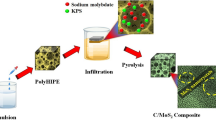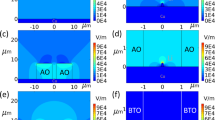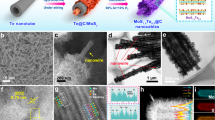Abstract
Among the candidates to replace Li-ion batteries, Li–S cells are an attractive option as their energy density is about five times higher (~2,600 Wh kg−1). The success of Li–S cells depends in large part on the utilization of metallic Li as anode material. Metallic lithium, however, is prone to grow parasitic dendrites and is highly reactive to several electrolytes; moreover, Li–S cells with metallic Li are also susceptible to polysulfides dissolution. Here, we show that ~10-nm-thick two-dimensional (2D) MoS2 can act as a protective layer for Li-metal anodes, greatly improving the performances of Li–S batteries. In particular, we observe stable Li electrodeposition and the suppression of dendrite nucleation sites. The deposition and dissolution process of a symmetric MoS2-coated Li-metal cell operates at a current density of 10 mA cm−2 with low voltage hysteresis and a threefold improvement in cycle life compared with using bare Li-metal. In a Li–S full-cell configuration, using the MoS2-coated Li as anode and a 3D carbon nanotube–sulfur cathode, we obtain a specific energy density of ~589 Wh kg−1 and a Coulombic efficiency of ~98% for over 1,200 cycles at 0.5 C. Our approach could lead to the realization of high energy density and safe Li-metal-based batteries.
This is a preview of subscription content, access via your institution
Access options
Access Nature and 54 other Nature Portfolio journals
Get Nature+, our best-value online-access subscription
$29.99 / 30 days
cancel any time
Subscribe to this journal
Receive 12 print issues and online access
$259.00 per year
only $21.58 per issue
Buy this article
- Purchase on Springer Link
- Instant access to full article PDF
Prices may be subject to local taxes which are calculated during checkout





Similar content being viewed by others
Change history
04 April 2018
In the version of this Article originally published, a technical error in typesetting led to the traces in Fig. 3a being trimmed and made to overlap. The figure has now been corrected with the traces as supplied by the authors; the original and corrected Fig. 3a are shown below. Also, in the last paragraph of the section “Mechanistic study on Li diffusion in MoS2” the authors incorrectly included the term ‘high-concentration’ in the text “the Li diffusion will be dominated by high-concentration Li migration on the surface of T-MoS2 with a much smaller energy barrier (0.155 eV) to overcome”. This term has now been removed from all versions of the Article. Finally, the authors have added an extra figure in the Supplementary Information (Supplementary Fig. 19) to show galvanostatic tests at 1 and 3 mA cm–2 for the MoS2-coated Li symmetric cells. The caption to Fig. 3 of the Article has been amended to reflect this, with the added wording “Galvanostatic tests at 1 and 3 mA cm–2 can be found in Supplementary Fig. 19.”
References
Grande, L. et al. The lithium/air battery: still an emerging system or a practical reality? Adv. Mater. 27, 784–800 (2015).
Lu, Y. et al. Stable cycling of lithium metal batteries using high transference number electrolytes. Adv. Energy Mater. 5, 1402073 (2015).
Xu, W. et al. Lithium metal anodes for rechargeable batteries. Energy Environ. Sci. 7, 513–537 (2014).
Manthiram, A., Fu, Y., Chung, S. H., Zu, C. & Su, Y. S. Rechargeable lithium–sulfur batteries. Chem. Rev. 114, 11751–11787 (2014).
Yamin, H., Gorenshtein, A., Penciner, J., Sternberg, Y. & Peled, E. Lithium sulfur battery. Oxidation/reduction mechanisms of polysulfides in THF solutions. J. Electrochem. Soc. 135, 1045–1048 (1988).
Peled, E. The electrochemical behavior of alkali and alkaline earth metals in nonaqueous battery systems—the solid electrolyte interphase model. J. Electrochem. Soc. 126, 2047–2051 (1979).
Li, G. et al. Three-dimensional porous carbon composites containing high sulfur nanoparticle content for high-performance lithium–sulfur batteries. Nat. Commun. 7, 10601 (2016).
Ma, L. et al. Enhanced Li–S batteries using amine-functionalized carbon nanotubes in the cathode. ACS Nano 10, 1050–1059 (2016).
Xiao, Z. et al Lightweight TiO2/graphene interlayer, applied as a highly effective polysulfide absorbent for fast, long-life lithium–sulfur batteries. Adv. Mater. 27, 2891–2898 (2015).
Jin, S. et al. Covalently connected carbon nanostructure for current collectors in both the cathode and anode of Li–S batteries. Adv. Mater. 28, 9094–9102 (2016).
Patel, M. D., Cha, E., Kang, C., Gwalani, B. & Choi, W. High performance rechargeable Li–S batteries using binder-free large sulfur loaded three-dimensional carbon nanotubes. Carbon 118, 120–126 (2017).
Qian, J. et al. High rate and stable cycling of lithium metal anode. Nat. Commun. 6, 6362 (2015).
Ding, F. et al. Dendrite-free lithium deposition via self-healing electrostatic shield mechanism. J. Am. Chem. Soc. 135, 4450–4456 (2013).
Zhang, J. et al. Superior conductive solid-like electrolytes: nano confining liquids within the hollow structures. Nano Lett. 15, 3398–3402 (2015).
Dudney, N. J. Addition of a thin-film inorganic solid electrolyte (lipon) as a protective film in lithium batteries with a liquid electrolyte. J. Power Sources 89, 176–179 (2000).
Zheng, G. Y. et al. Interconnected hollow carbon nanospheres for stable lithium metal anodes. Nat. Nanotech. 9, 618–623 (2014).
Lee, H., Lee, D. J., Kim, Y.-J., Park, J.-K. & Kim, H.-T. A simple composite protective layer coating that enhances the cycling stability of lithium metal batteries. J. Power Sources 284, 103–108 (2015).
Kozen, A. C. et al. Next-generation lithium metal anode engineering via atomic layer deposition. ACS Nano 9, 5884–5892 (2015).
Yan, K. et al. Ultrathin two-dimensional atomic crystals as stable interfacial layer for improvement of lithium metal anode. Nano Lett. 14, 6016–6022 (2014).
Zhang, R. et al. Conductive nanostructured scaffolds render low local current density to inhibit lithium dendrite growth. Adv. Mater. 28, 2155–2162 (2016).
Aurbach, D., Zinigrad, E., Cohen, Y. & Teller, H. A short review of failure mechanisms of lithium metal and lithiated graphite anodes in liquid electrolyte solutions. Solid State Ion. 148, 405–416 (2002).
Lu, Y., Tu, Z. & Archer, L. A. Stable lithium electrodeposition in liquid and nanoporous solid electrolytes. Nat. Mater. 13, 961–969 (2014).
Wang, D. et al. Towards high-safe lithium metal anodes: suppressing lithium dendrites via tuning surface energy. Adv. Sci. 4, 1600168 (2017).
Wang, Q. H., Kalantar-Zadeh, K., Kis, A., Coleman, J. N. & Strano, M. S. Electronics and optoelectronics of two-dimensional transition metal dichalcogenides. Nat. Nanotech. 7, 699–712 (2012).
Chhowalla, M. et al. The chemistry of two-dimensional layered transition metal dichalcogenide nanosheets. Nat. Chem. 5, 263–275 (2013).
Dickinson, R. G. & Pauling, L. The crystal structure of molybdenite. J. Am. Chem. Soc. 45, 1466–1471 (1923).
Bieker, G., Winter, M. & Bieker, P. Electrochemical in situ investigations of SEI and dendrite formation on the lithium metal anode. Phys. Chem. Chem. Phys. 17, 8670–8679 (2015).
Nayak, A. P. et al. Pressure-dependent optical and vibrational properties of monolayer molybdenum disulfide. Nano Lett. 15, 346–353 (2014).
Py, M. & Haering, R. Structural destabilization induced by lithium intercalation in MoS2 and related compounds. Can. J. Phys. 61, 76–84 (1983).
Santa Ana, M., Mirabal, N., Benayenta, E., Gomez-Romero, P. & Gonzalez, G. Electrochemical behavior of lithium intercalated in a molybdenum disulfide-crown ether nanocomposite. Electrochim. Acta 53, 1432–1438 (2007).
Teng, Y. et al. MoS2 nanosheets vertically grown on graphene sheets for lithium-ion battery anodes. ACS Nano 10, 8526–8535 (2016).
Nayak, A. P. et al. Pressure-induced semiconducting to metallic transition in multilayered molybdenum disulphide. Nat. Commun. 5, 3731 (2014).
Yang, L. et al. Lattice strain effects on the optical properties of MoS2 nanosheets. Sci. Rep. 4, 5649 (2014).
Kappera, R. et al. Phase-engineered low-resistance contacts for ultrathin MoS2 transistors. Nat. Mater. 13, 1128–1134 (2014).
Fang, R. et al. 3D interconnected electrode materials with ultrahigh areal sulfur loading for Li–S batteries. Adv. Mater. 28, 3374–3382 (2016).
Zhang, S. S. New insight into liquid electrolyte of rechargeable lithium/sulfur battery. Electrochim. Acta 97, 226–230 (2013).
Kim, H., Lee, J., Ahn, H., Kim, O. & Park, M. J. Synthesis of three-dimensionally interconnected sulfur-rich polymers for cathode materials of high-rate lithium–sulfur batteries. Nat. Commun. 6, 7278 (2015).
Zhao, M.-Q. et al. Hierarchical vine-tree-like carbon nanotube architectures: in-situ CVD self-assembly and their use as robust scaffolds for lithium-sulfur batteries. Adv. Mater. 26, 7051–7058 (2014).
Song, M.-K., Zhang, Y. & Cairns, E. J. A long-life, high-rate lithium/sulfur cell: a multifaceted approach to enhancing cell performance. Nano Lett. 13, 5891–5899 (2013).
Zhao, M.-Q. et al. Unstacked double layer templated graphene for high-rate lithium–sulphur batteries. Nat. Commun. 5, 3410 (2014).
Zhou, Y. et al. Enabling prominent high-rate and cycle performances in one lithium–sulfur battery: designing perm-selective gateways for Li+ transportation in holey-CNT/S cathodes. Adv. Mater. 27, 3774–3781 (2015).
Liu, Q.-C. et al. Artificial protection film on lithium metal anode toward long-cycle-life lithium–oxygen batteries. Adv. Mater. 27, 5241–5247 (2015).
Cheng, X.-B. et al. Implantable solid electrolyte interphase in lithium-metal batteries. Chem 2, 258–270 (2017).
Hohenberg, P. & Kohn, W. Inhomogeneous electron gas. Phys. Rev. 136, B864–B871 (1964).
Kresse, G. & Joubert, D. From ultra-soft pseudopotentials to the projector augmented-wave method. Phys. Rev. B 59, 1758–1775 (1999).
Kresse, G. & Furthmüller, J. Efficient iterative schemes for ab initio total-energy calculations using a plane-wave basis set. Phys. Rev. B 54, 11169–11186 (1996).
Kresse, G. & Furthmüller, J. Efficiency of ab-initio total energy calculations for metals and semiconductors using a plane-wave basis set. Comput. Mater. Sci. 6, 15–50 (1996).
Petrova, N. V., Yakovkin, I. N. & Zeze, D. A. Metallization and stiffness of the Li-intercalated MoS2 bilayer. Appl. Surf. Sci. 353, 333–337 (2015).
Sheppard, D., Xiao, P., Chemelewski, W., Johnson, D. D. & Henkelman, G. A generalized solid-state nudged elastic band method. J. Chem. Phys. 136, 074103 (2012).
Acknowledgements
The authors thank J. Tour for discussions. We also thank KIST Jeonbuk (Korea Institute of Science and Technology at Jeonbuk) for providing the facility to carry out HRTEM and B. Gwalani for helping out with additional EDX analysis. W.C. acknowledges partial financial support from SEED fund at University of North Texas. K.C. acknowledges a part of financial support by the International Energy Joint R & D Program (No. 20168510011350) of the Korea Institute of Energy Technology Evaluation and Planning (KETEP), the Ministry of Knowledge Economy and the National Research Foundation of Creative Materials Discovery Program (2015M3D1A1068062).
Author information
Authors and Affiliations
Contributions
W.C. conceived the idea and designed the experiments. E.C. performed the cell fabrication, battery testing, SEM and TEM characterizations. W.C. and E.C. wrote the manuscript. M.D.P. performed the EIS measurements and cathode characterization. J.P. performed nano coating and analysed the Raman and XPS data. J.H. and K.C. performed the numerical simulation and provided data analysis. V.P. analysed the materials characterization data and edited the manuscript. All authors have discussed the results, read the manuscript and agreed with its content.
Corresponding author
Ethics declarations
Competing interests
The authors declare no competing financial interests.
Additional information
Publisher’s note: Springer Nature remains neutral with regard to jurisdictional claims in published maps and institutional affiliations.
Supplementary information
Supplementary Information
Supplementary Notes 1–4 and Supplementary Figures 1–19, Supplementary Tables 1–2.
Rights and permissions
About this article
Cite this article
Cha, E., Patel, M.D., Park, J. et al. 2D MoS2 as an efficient protective layer for lithium metal anodes in high-performance Li–S batteries. Nature Nanotech 13, 337–344 (2018). https://doi.org/10.1038/s41565-018-0061-y
Received:
Accepted:
Published:
Issue Date:
DOI: https://doi.org/10.1038/s41565-018-0061-y
This article is cited by
-
Interfacial self-healing polymer electrolytes for long-cycle solid-state lithium-sulfur batteries
Nature Communications (2024)
-
Advance in reversible Zn anodes promoted by 2D materials
Rare Metals (2024)
-
Intrinsic lithiophilic carbon host derived from bacterial cellulose nanofiber for dendrite-free and long-life lithium metal anode
Nano Research (2024)
-
MOF and its derivative materials modified lithium–sulfur battery separator: a new means to improve performance
Rare Metals (2024)
-
Two-dimensional materials for high density, safe and robust metal anodes batteries
Nano Convergence (2023)



